Teaching and Learning in Aboriginal Education Report 2022
VerifiedAdded on 2022/09/17
|9
|2573
|18
AI Summary
Contribute Materials
Your contribution can guide someone’s learning journey. Share your
documents today.
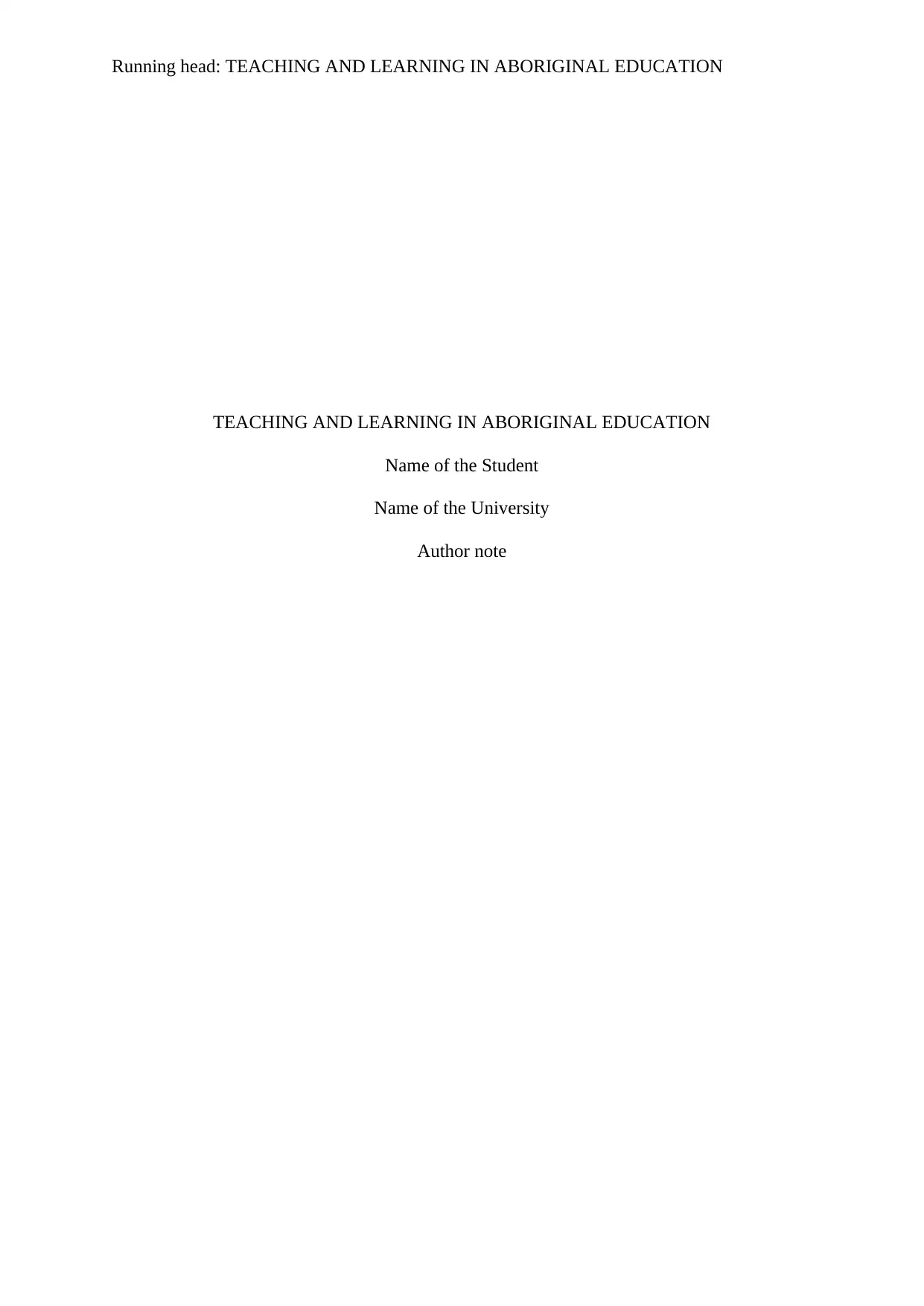
Running head: TEACHING AND LEARNING IN ABORIGINAL EDUCATION
TEACHING AND LEARNING IN ABORIGINAL EDUCATION
Name of the Student
Name of the University
Author note
TEACHING AND LEARNING IN ABORIGINAL EDUCATION
Name of the Student
Name of the University
Author note
Secure Best Marks with AI Grader
Need help grading? Try our AI Grader for instant feedback on your assignments.
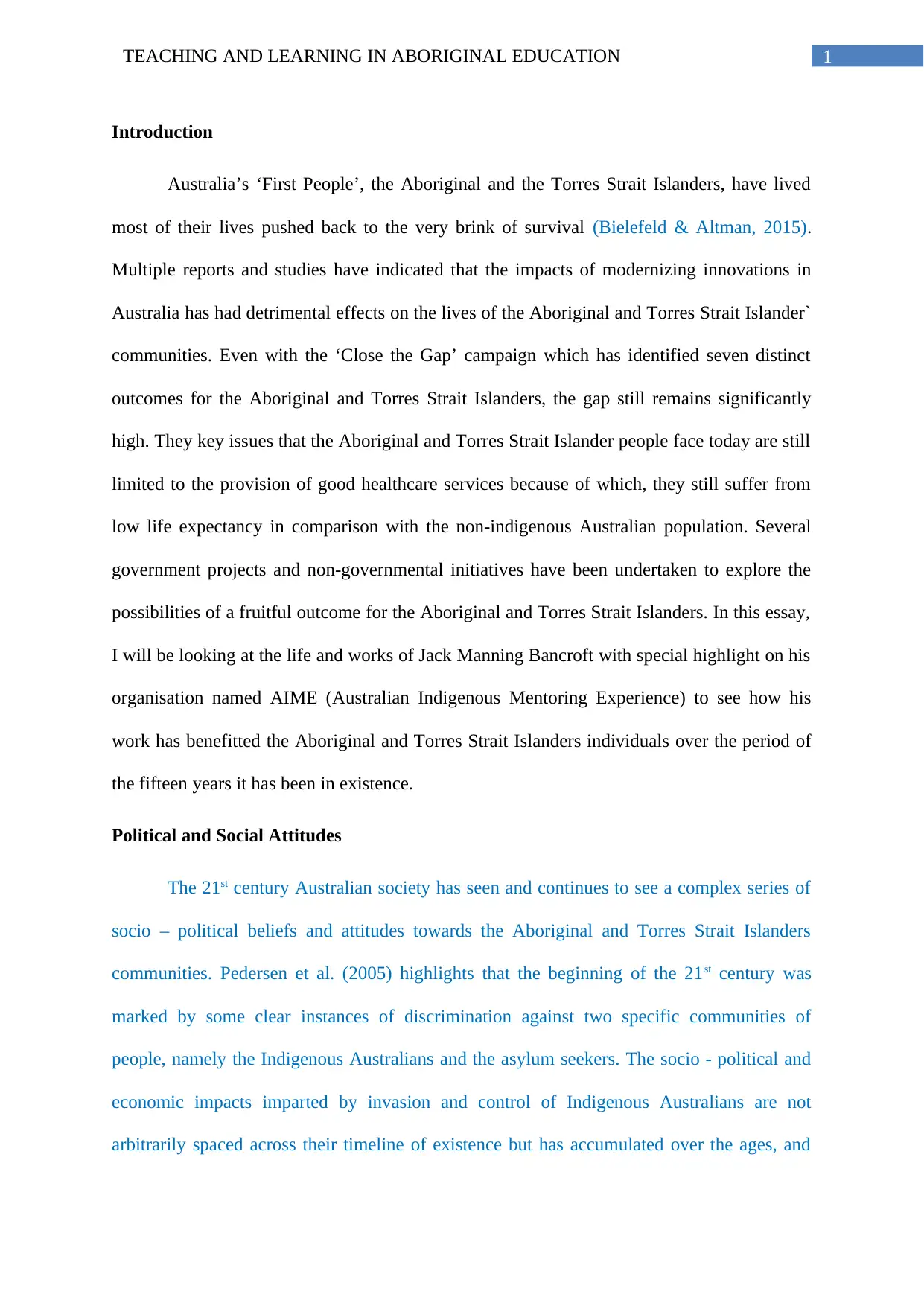
1TEACHING AND LEARNING IN ABORIGINAL EDUCATION
Introduction
Australia’s ‘First People’, the Aboriginal and the Torres Strait Islanders, have lived
most of their lives pushed back to the very brink of survival (Bielefeld & Altman, 2015).
Multiple reports and studies have indicated that the impacts of modernizing innovations in
Australia has had detrimental effects on the lives of the Aboriginal and Torres Strait Islander`
communities. Even with the ‘Close the Gap’ campaign which has identified seven distinct
outcomes for the Aboriginal and Torres Strait Islanders, the gap still remains significantly
high. They key issues that the Aboriginal and Torres Strait Islander people face today are still
limited to the provision of good healthcare services because of which, they still suffer from
low life expectancy in comparison with the non-indigenous Australian population. Several
government projects and non-governmental initiatives have been undertaken to explore the
possibilities of a fruitful outcome for the Aboriginal and Torres Strait Islanders. In this essay,
I will be looking at the life and works of Jack Manning Bancroft with special highlight on his
organisation named AIME (Australian Indigenous Mentoring Experience) to see how his
work has benefitted the Aboriginal and Torres Strait Islanders individuals over the period of
the fifteen years it has been in existence.
Political and Social Attitudes
The 21st century Australian society has seen and continues to see a complex series of
socio – political beliefs and attitudes towards the Aboriginal and Torres Strait Islanders
communities. Pedersen et al. (2005) highlights that the beginning of the 21st century was
marked by some clear instances of discrimination against two specific communities of
people, namely the Indigenous Australians and the asylum seekers. The socio - political and
economic impacts imparted by invasion and control of Indigenous Australians are not
arbitrarily spaced across their timeline of existence but has accumulated over the ages, and
Introduction
Australia’s ‘First People’, the Aboriginal and the Torres Strait Islanders, have lived
most of their lives pushed back to the very brink of survival (Bielefeld & Altman, 2015).
Multiple reports and studies have indicated that the impacts of modernizing innovations in
Australia has had detrimental effects on the lives of the Aboriginal and Torres Strait Islander`
communities. Even with the ‘Close the Gap’ campaign which has identified seven distinct
outcomes for the Aboriginal and Torres Strait Islanders, the gap still remains significantly
high. They key issues that the Aboriginal and Torres Strait Islander people face today are still
limited to the provision of good healthcare services because of which, they still suffer from
low life expectancy in comparison with the non-indigenous Australian population. Several
government projects and non-governmental initiatives have been undertaken to explore the
possibilities of a fruitful outcome for the Aboriginal and Torres Strait Islanders. In this essay,
I will be looking at the life and works of Jack Manning Bancroft with special highlight on his
organisation named AIME (Australian Indigenous Mentoring Experience) to see how his
work has benefitted the Aboriginal and Torres Strait Islanders individuals over the period of
the fifteen years it has been in existence.
Political and Social Attitudes
The 21st century Australian society has seen and continues to see a complex series of
socio – political beliefs and attitudes towards the Aboriginal and Torres Strait Islanders
communities. Pedersen et al. (2005) highlights that the beginning of the 21st century was
marked by some clear instances of discrimination against two specific communities of
people, namely the Indigenous Australians and the asylum seekers. The socio - political and
economic impacts imparted by invasion and control of Indigenous Australians are not
arbitrarily spaced across their timeline of existence but has accumulated over the ages, and
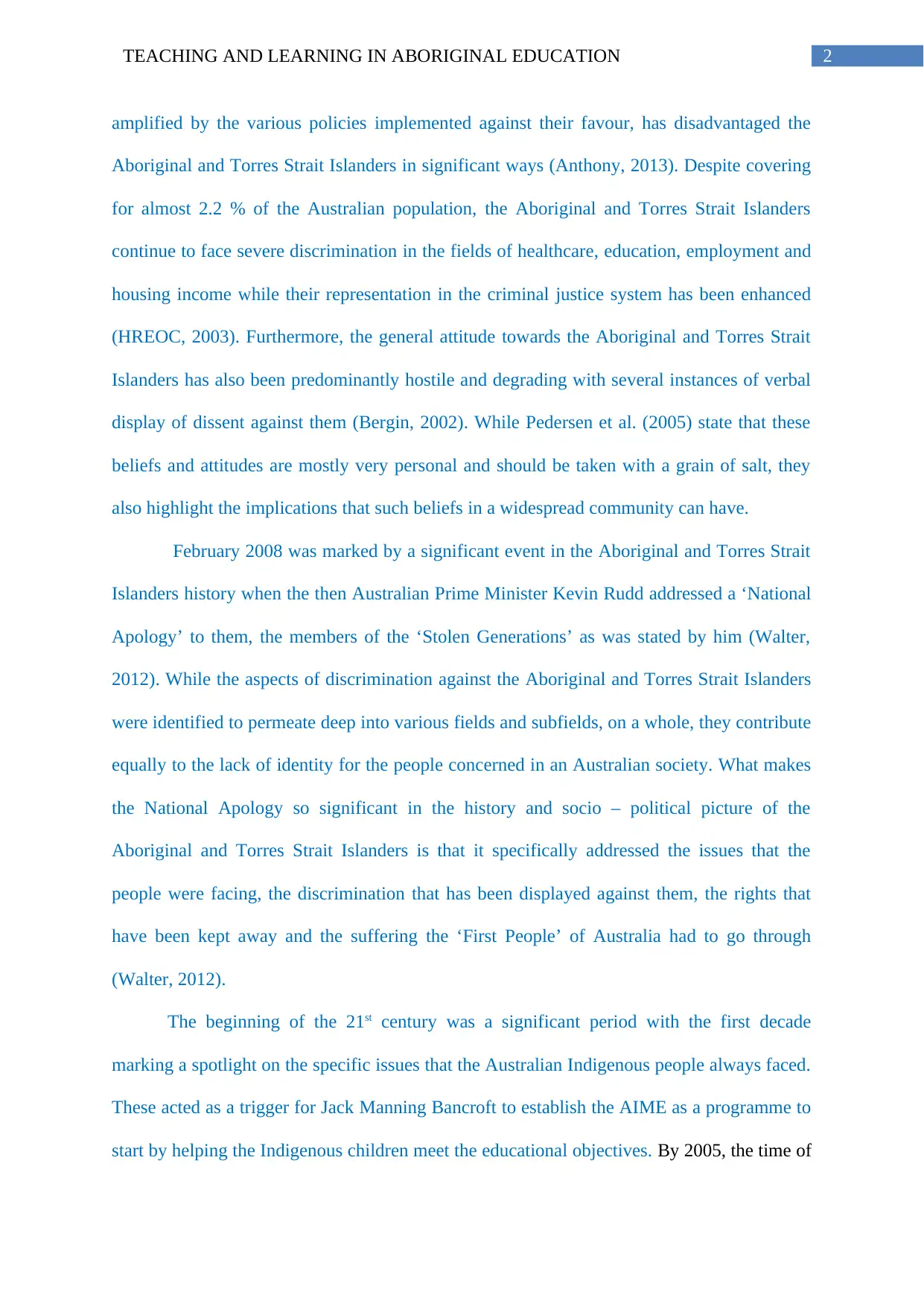
2TEACHING AND LEARNING IN ABORIGINAL EDUCATION
amplified by the various policies implemented against their favour, has disadvantaged the
Aboriginal and Torres Strait Islanders in significant ways (Anthony, 2013). Despite covering
for almost 2.2 % of the Australian population, the Aboriginal and Torres Strait Islanders
continue to face severe discrimination in the fields of healthcare, education, employment and
housing income while their representation in the criminal justice system has been enhanced
(HREOC, 2003). Furthermore, the general attitude towards the Aboriginal and Torres Strait
Islanders has also been predominantly hostile and degrading with several instances of verbal
display of dissent against them (Bergin, 2002). While Pedersen et al. (2005) state that these
beliefs and attitudes are mostly very personal and should be taken with a grain of salt, they
also highlight the implications that such beliefs in a widespread community can have.
February 2008 was marked by a significant event in the Aboriginal and Torres Strait
Islanders history when the then Australian Prime Minister Kevin Rudd addressed a ‘National
Apology’ to them, the members of the ‘Stolen Generations’ as was stated by him (Walter,
2012). While the aspects of discrimination against the Aboriginal and Torres Strait Islanders
were identified to permeate deep into various fields and subfields, on a whole, they contribute
equally to the lack of identity for the people concerned in an Australian society. What makes
the National Apology so significant in the history and socio – political picture of the
Aboriginal and Torres Strait Islanders is that it specifically addressed the issues that the
people were facing, the discrimination that has been displayed against them, the rights that
have been kept away and the suffering the ‘First People’ of Australia had to go through
(Walter, 2012).
The beginning of the 21st century was a significant period with the first decade
marking a spotlight on the specific issues that the Australian Indigenous people always faced.
These acted as a trigger for Jack Manning Bancroft to establish the AIME as a programme to
start by helping the Indigenous children meet the educational objectives. By 2005, the time of
amplified by the various policies implemented against their favour, has disadvantaged the
Aboriginal and Torres Strait Islanders in significant ways (Anthony, 2013). Despite covering
for almost 2.2 % of the Australian population, the Aboriginal and Torres Strait Islanders
continue to face severe discrimination in the fields of healthcare, education, employment and
housing income while their representation in the criminal justice system has been enhanced
(HREOC, 2003). Furthermore, the general attitude towards the Aboriginal and Torres Strait
Islanders has also been predominantly hostile and degrading with several instances of verbal
display of dissent against them (Bergin, 2002). While Pedersen et al. (2005) state that these
beliefs and attitudes are mostly very personal and should be taken with a grain of salt, they
also highlight the implications that such beliefs in a widespread community can have.
February 2008 was marked by a significant event in the Aboriginal and Torres Strait
Islanders history when the then Australian Prime Minister Kevin Rudd addressed a ‘National
Apology’ to them, the members of the ‘Stolen Generations’ as was stated by him (Walter,
2012). While the aspects of discrimination against the Aboriginal and Torres Strait Islanders
were identified to permeate deep into various fields and subfields, on a whole, they contribute
equally to the lack of identity for the people concerned in an Australian society. What makes
the National Apology so significant in the history and socio – political picture of the
Aboriginal and Torres Strait Islanders is that it specifically addressed the issues that the
people were facing, the discrimination that has been displayed against them, the rights that
have been kept away and the suffering the ‘First People’ of Australia had to go through
(Walter, 2012).
The beginning of the 21st century was a significant period with the first decade
marking a spotlight on the specific issues that the Australian Indigenous people always faced.
These acted as a trigger for Jack Manning Bancroft to establish the AIME as a programme to
start by helping the Indigenous children meet the educational objectives. By 2005, the time of
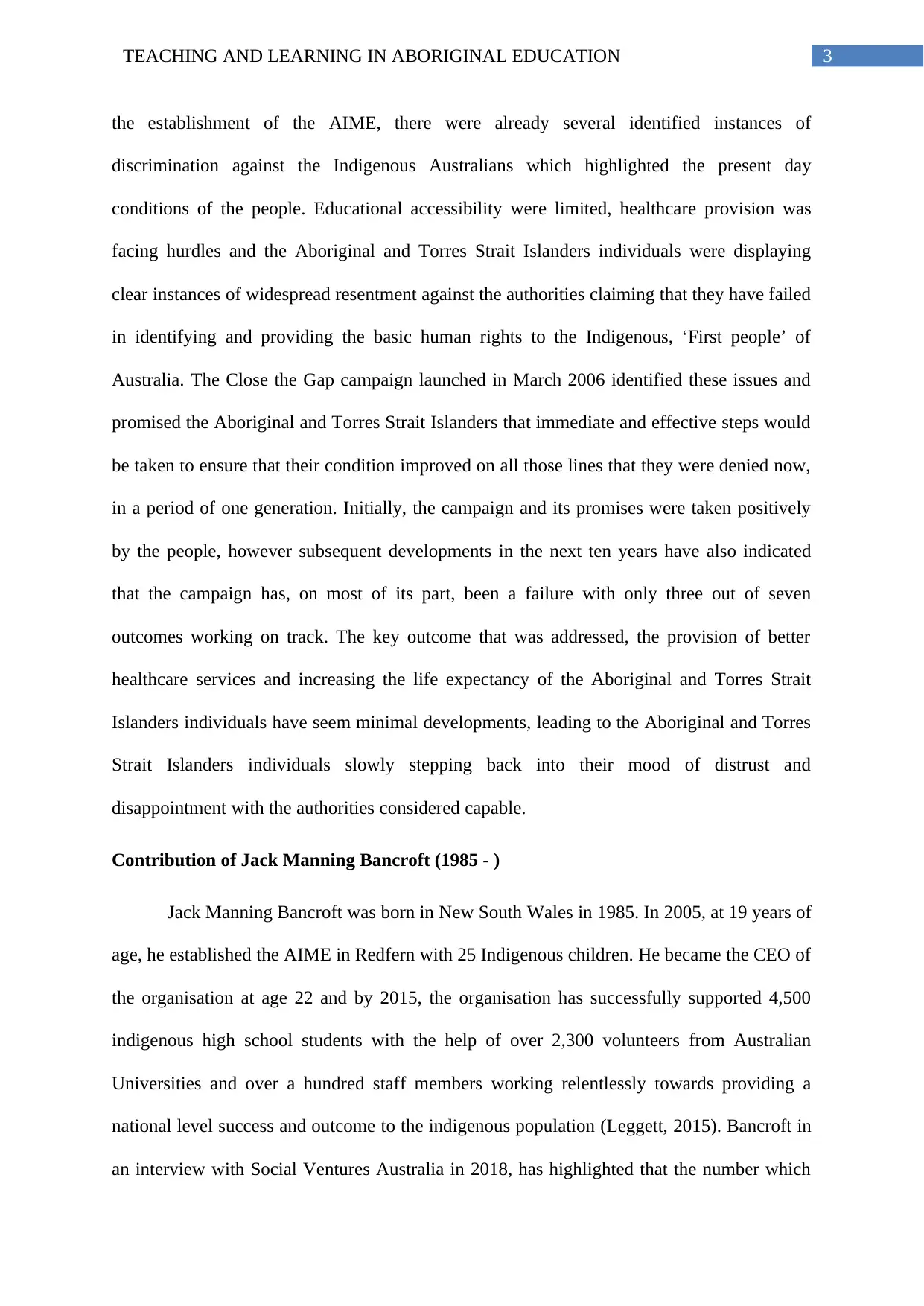
3TEACHING AND LEARNING IN ABORIGINAL EDUCATION
the establishment of the AIME, there were already several identified instances of
discrimination against the Indigenous Australians which highlighted the present day
conditions of the people. Educational accessibility were limited, healthcare provision was
facing hurdles and the Aboriginal and Torres Strait Islanders individuals were displaying
clear instances of widespread resentment against the authorities claiming that they have failed
in identifying and providing the basic human rights to the Indigenous, ‘First people’ of
Australia. The Close the Gap campaign launched in March 2006 identified these issues and
promised the Aboriginal and Torres Strait Islanders that immediate and effective steps would
be taken to ensure that their condition improved on all those lines that they were denied now,
in a period of one generation. Initially, the campaign and its promises were taken positively
by the people, however subsequent developments in the next ten years have also indicated
that the campaign has, on most of its part, been a failure with only three out of seven
outcomes working on track. The key outcome that was addressed, the provision of better
healthcare services and increasing the life expectancy of the Aboriginal and Torres Strait
Islanders individuals have seem minimal developments, leading to the Aboriginal and Torres
Strait Islanders individuals slowly stepping back into their mood of distrust and
disappointment with the authorities considered capable.
Contribution of Jack Manning Bancroft (1985 - )
Jack Manning Bancroft was born in New South Wales in 1985. In 2005, at 19 years of
age, he established the AIME in Redfern with 25 Indigenous children. He became the CEO of
the organisation at age 22 and by 2015, the organisation has successfully supported 4,500
indigenous high school students with the help of over 2,300 volunteers from Australian
Universities and over a hundred staff members working relentlessly towards providing a
national level success and outcome to the indigenous population (Leggett, 2015). Bancroft in
an interview with Social Ventures Australia in 2018, has highlighted that the number which
the establishment of the AIME, there were already several identified instances of
discrimination against the Indigenous Australians which highlighted the present day
conditions of the people. Educational accessibility were limited, healthcare provision was
facing hurdles and the Aboriginal and Torres Strait Islanders individuals were displaying
clear instances of widespread resentment against the authorities claiming that they have failed
in identifying and providing the basic human rights to the Indigenous, ‘First people’ of
Australia. The Close the Gap campaign launched in March 2006 identified these issues and
promised the Aboriginal and Torres Strait Islanders that immediate and effective steps would
be taken to ensure that their condition improved on all those lines that they were denied now,
in a period of one generation. Initially, the campaign and its promises were taken positively
by the people, however subsequent developments in the next ten years have also indicated
that the campaign has, on most of its part, been a failure with only three out of seven
outcomes working on track. The key outcome that was addressed, the provision of better
healthcare services and increasing the life expectancy of the Aboriginal and Torres Strait
Islanders individuals have seem minimal developments, leading to the Aboriginal and Torres
Strait Islanders individuals slowly stepping back into their mood of distrust and
disappointment with the authorities considered capable.
Contribution of Jack Manning Bancroft (1985 - )
Jack Manning Bancroft was born in New South Wales in 1985. In 2005, at 19 years of
age, he established the AIME in Redfern with 25 Indigenous children. He became the CEO of
the organisation at age 22 and by 2015, the organisation has successfully supported 4,500
indigenous high school students with the help of over 2,300 volunteers from Australian
Universities and over a hundred staff members working relentlessly towards providing a
national level success and outcome to the indigenous population (Leggett, 2015). Bancroft in
an interview with Social Ventures Australia in 2018, has highlighted that the number which
Secure Best Marks with AI Grader
Need help grading? Try our AI Grader for instant feedback on your assignments.

4TEACHING AND LEARNING IN ABORIGINAL EDUCATION
has increased from 2015 to accommodate 15,000 plus students and 5,000 plus volunteers, has
been the greatest impact of AIME. Bancroft also highlights that the benefits of AIME
programme involves better education for the Indigenous individuals in general, and the
statistics of AIME show that the outcome has been met, with a growing number of students
enrolling in the AIME programme as well as an ever increasing volunteer count (Bancroft &
Bashir, 2018). While speaking of background, Bancroft highlights that the key purpose
behind the job as well as the objective with which AIME functions has been and will be for
the foreseeable future, bringing about an equal base for both the non-indigenous children as
well as the Aboriginal and Torres Strait Islanders children in education in school as well as
post school period (Harwood et al, 2013). The highlight of the target has always been a
positive outcome for the concerned Aboriginal and Torres Strait Islanders children and the
results of the AIME programme in the past fifteen years have indicated nothing otherwise
(Bancroft & Bashir, 2018).
There are deep set socio – cultural implications of AIME as Bancroft further states
(Bancroft & Bashir, 2018). With more than 50 % of the AIME staff belong to the Aboriginal
and Torres Strait Islanders communities, as identified by the Australian Institute of Family
Studies ("Australian Indigenous Mentoring Experience - Knowledge Circle Practice
Profiles", n.d.). Besides, the board of officials in AIME is also made up of more than 50 %
Aboriginal and Torres Strait Islanders individuals, while the rest are the support members as
well as faculties from around the world who are invested in providing service as well as
conducting further research and evaluation. This highlights that the primary focus of Bancroft
as well as the AIME programme is the provision and elaboration of deep set cultural
identities for the Aboriginal and Torres Strait Islanders people and fostering a sense of
powerful harmony between the Indigenous and Non – Indigenous children (Harwood et al.,
2013). AIME celebrates the contemporary Indigenous culture deeply by demonstrating the
has increased from 2015 to accommodate 15,000 plus students and 5,000 plus volunteers, has
been the greatest impact of AIME. Bancroft also highlights that the benefits of AIME
programme involves better education for the Indigenous individuals in general, and the
statistics of AIME show that the outcome has been met, with a growing number of students
enrolling in the AIME programme as well as an ever increasing volunteer count (Bancroft &
Bashir, 2018). While speaking of background, Bancroft highlights that the key purpose
behind the job as well as the objective with which AIME functions has been and will be for
the foreseeable future, bringing about an equal base for both the non-indigenous children as
well as the Aboriginal and Torres Strait Islanders children in education in school as well as
post school period (Harwood et al, 2013). The highlight of the target has always been a
positive outcome for the concerned Aboriginal and Torres Strait Islanders children and the
results of the AIME programme in the past fifteen years have indicated nothing otherwise
(Bancroft & Bashir, 2018).
There are deep set socio – cultural implications of AIME as Bancroft further states
(Bancroft & Bashir, 2018). With more than 50 % of the AIME staff belong to the Aboriginal
and Torres Strait Islanders communities, as identified by the Australian Institute of Family
Studies ("Australian Indigenous Mentoring Experience - Knowledge Circle Practice
Profiles", n.d.). Besides, the board of officials in AIME is also made up of more than 50 %
Aboriginal and Torres Strait Islanders individuals, while the rest are the support members as
well as faculties from around the world who are invested in providing service as well as
conducting further research and evaluation. This highlights that the primary focus of Bancroft
as well as the AIME programme is the provision and elaboration of deep set cultural
identities for the Aboriginal and Torres Strait Islanders people and fostering a sense of
powerful harmony between the Indigenous and Non – Indigenous children (Harwood et al.,
2013). AIME celebrates the contemporary Indigenous culture deeply by demonstrating the
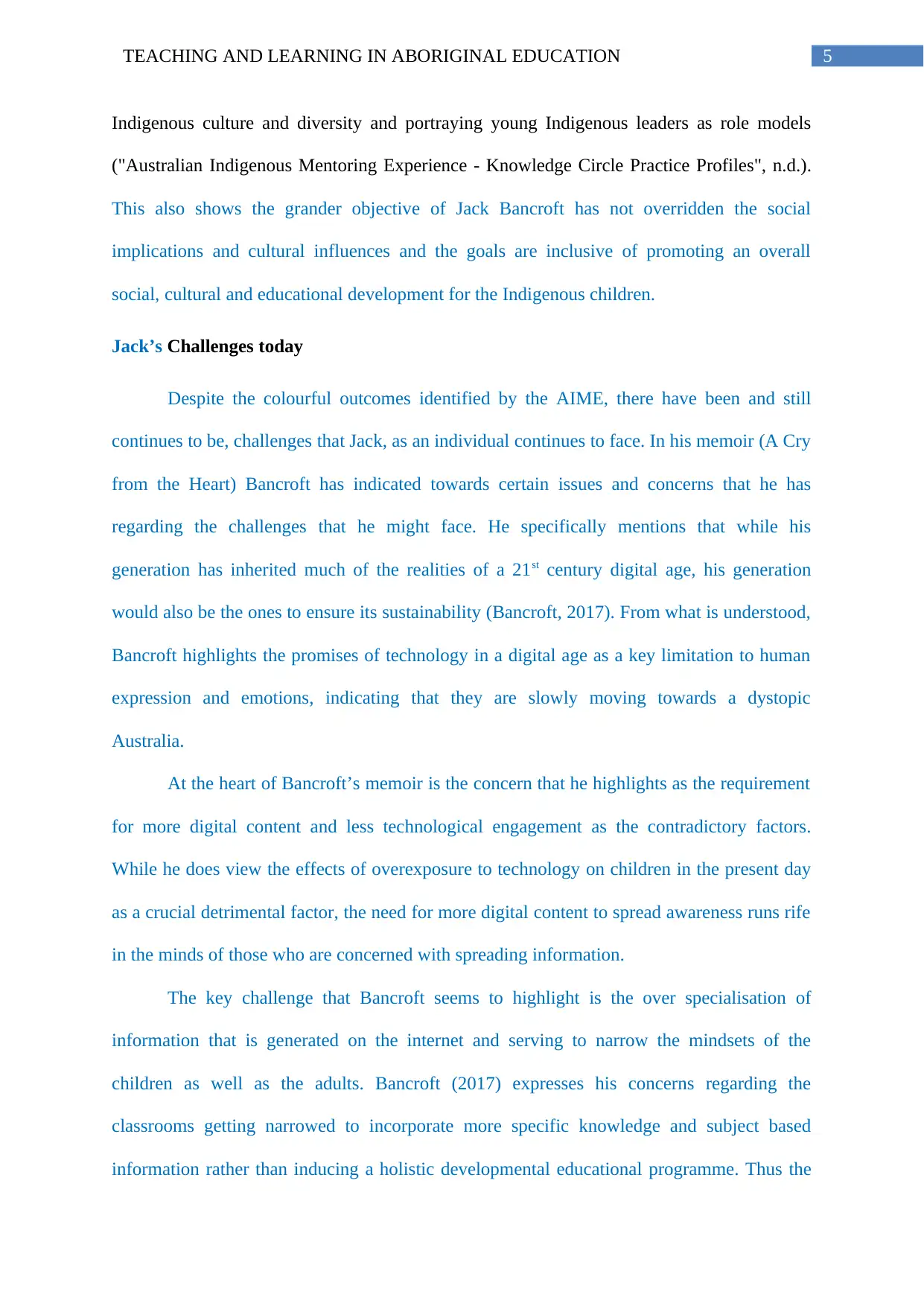
5TEACHING AND LEARNING IN ABORIGINAL EDUCATION
Indigenous culture and diversity and portraying young Indigenous leaders as role models
("Australian Indigenous Mentoring Experience - Knowledge Circle Practice Profiles", n.d.).
This also shows the grander objective of Jack Bancroft has not overridden the social
implications and cultural influences and the goals are inclusive of promoting an overall
social, cultural and educational development for the Indigenous children.
Jack’s Challenges today
Despite the colourful outcomes identified by the AIME, there have been and still
continues to be, challenges that Jack, as an individual continues to face. In his memoir (A Cry
from the Heart) Bancroft has indicated towards certain issues and concerns that he has
regarding the challenges that he might face. He specifically mentions that while his
generation has inherited much of the realities of a 21st century digital age, his generation
would also be the ones to ensure its sustainability (Bancroft, 2017). From what is understood,
Bancroft highlights the promises of technology in a digital age as a key limitation to human
expression and emotions, indicating that they are slowly moving towards a dystopic
Australia.
At the heart of Bancroft’s memoir is the concern that he highlights as the requirement
for more digital content and less technological engagement as the contradictory factors.
While he does view the effects of overexposure to technology on children in the present day
as a crucial detrimental factor, the need for more digital content to spread awareness runs rife
in the minds of those who are concerned with spreading information.
The key challenge that Bancroft seems to highlight is the over specialisation of
information that is generated on the internet and serving to narrow the mindsets of the
children as well as the adults. Bancroft (2017) expresses his concerns regarding the
classrooms getting narrowed to incorporate more specific knowledge and subject based
information rather than inducing a holistic developmental educational programme. Thus the
Indigenous culture and diversity and portraying young Indigenous leaders as role models
("Australian Indigenous Mentoring Experience - Knowledge Circle Practice Profiles", n.d.).
This also shows the grander objective of Jack Bancroft has not overridden the social
implications and cultural influences and the goals are inclusive of promoting an overall
social, cultural and educational development for the Indigenous children.
Jack’s Challenges today
Despite the colourful outcomes identified by the AIME, there have been and still
continues to be, challenges that Jack, as an individual continues to face. In his memoir (A Cry
from the Heart) Bancroft has indicated towards certain issues and concerns that he has
regarding the challenges that he might face. He specifically mentions that while his
generation has inherited much of the realities of a 21st century digital age, his generation
would also be the ones to ensure its sustainability (Bancroft, 2017). From what is understood,
Bancroft highlights the promises of technology in a digital age as a key limitation to human
expression and emotions, indicating that they are slowly moving towards a dystopic
Australia.
At the heart of Bancroft’s memoir is the concern that he highlights as the requirement
for more digital content and less technological engagement as the contradictory factors.
While he does view the effects of overexposure to technology on children in the present day
as a crucial detrimental factor, the need for more digital content to spread awareness runs rife
in the minds of those who are concerned with spreading information.
The key challenge that Bancroft seems to highlight is the over specialisation of
information that is generated on the internet and serving to narrow the mindsets of the
children as well as the adults. Bancroft (2017) expresses his concerns regarding the
classrooms getting narrowed to incorporate more specific knowledge and subject based
information rather than inducing a holistic developmental educational programme. Thus the
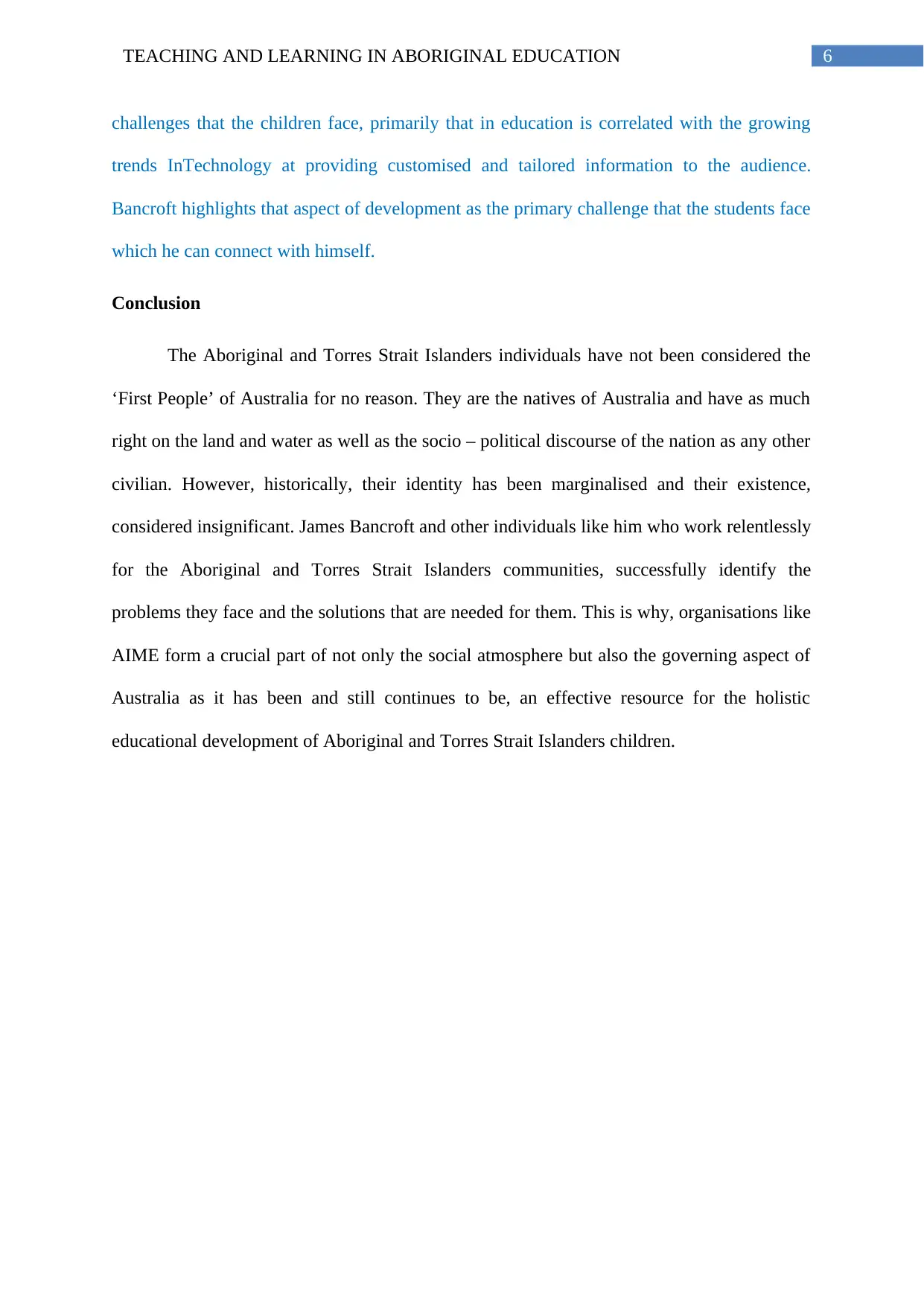
6TEACHING AND LEARNING IN ABORIGINAL EDUCATION
challenges that the children face, primarily that in education is correlated with the growing
trends InTechnology at providing customised and tailored information to the audience.
Bancroft highlights that aspect of development as the primary challenge that the students face
which he can connect with himself.
Conclusion
The Aboriginal and Torres Strait Islanders individuals have not been considered the
‘First People’ of Australia for no reason. They are the natives of Australia and have as much
right on the land and water as well as the socio – political discourse of the nation as any other
civilian. However, historically, their identity has been marginalised and their existence,
considered insignificant. James Bancroft and other individuals like him who work relentlessly
for the Aboriginal and Torres Strait Islanders communities, successfully identify the
problems they face and the solutions that are needed for them. This is why, organisations like
AIME form a crucial part of not only the social atmosphere but also the governing aspect of
Australia as it has been and still continues to be, an effective resource for the holistic
educational development of Aboriginal and Torres Strait Islanders children.
challenges that the children face, primarily that in education is correlated with the growing
trends InTechnology at providing customised and tailored information to the audience.
Bancroft highlights that aspect of development as the primary challenge that the students face
which he can connect with himself.
Conclusion
The Aboriginal and Torres Strait Islanders individuals have not been considered the
‘First People’ of Australia for no reason. They are the natives of Australia and have as much
right on the land and water as well as the socio – political discourse of the nation as any other
civilian. However, historically, their identity has been marginalised and their existence,
considered insignificant. James Bancroft and other individuals like him who work relentlessly
for the Aboriginal and Torres Strait Islanders communities, successfully identify the
problems they face and the solutions that are needed for them. This is why, organisations like
AIME form a crucial part of not only the social atmosphere but also the governing aspect of
Australia as it has been and still continues to be, an effective resource for the holistic
educational development of Aboriginal and Torres Strait Islanders children.
Paraphrase This Document
Need a fresh take? Get an instant paraphrase of this document with our AI Paraphraser
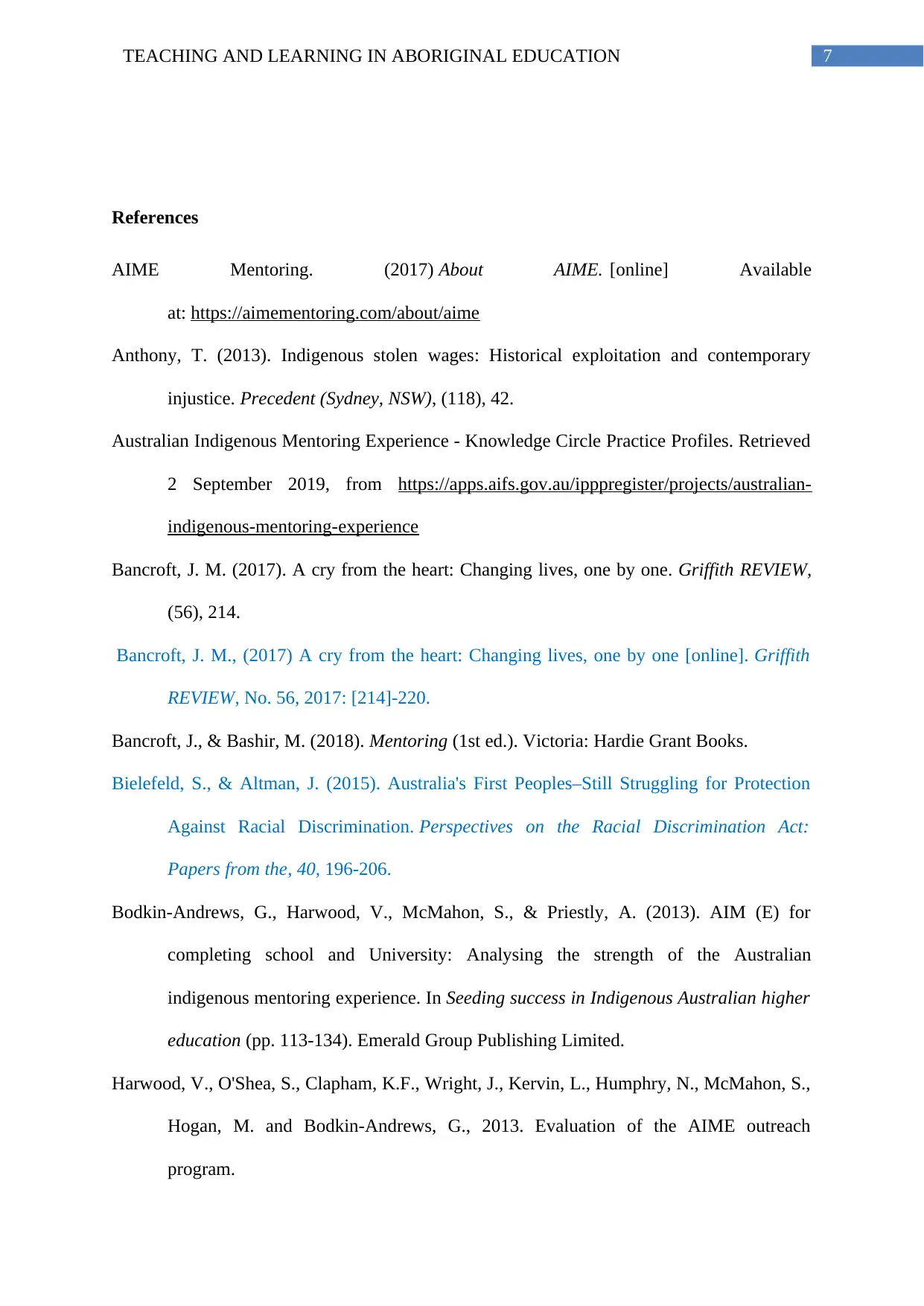
7TEACHING AND LEARNING IN ABORIGINAL EDUCATION
References
AIME Mentoring. (2017) About AIME. [online] Available
at: https://aimementoring.com/about/aime
Anthony, T. (2013). Indigenous stolen wages: Historical exploitation and contemporary
injustice. Precedent (Sydney, NSW), (118), 42.
Australian Indigenous Mentoring Experience - Knowledge Circle Practice Profiles. Retrieved
2 September 2019, from https://apps.aifs.gov.au/ipppregister/projects/australian-
indigenous-mentoring-experience
Bancroft, J. M. (2017). A cry from the heart: Changing lives, one by one. Griffith REVIEW,
(56), 214.
Bancroft, J. M., (2017) A cry from the heart: Changing lives, one by one [online]. Griffith
REVIEW, No. 56, 2017: [214]-220.
Bancroft, J., & Bashir, M. (2018). Mentoring (1st ed.). Victoria: Hardie Grant Books.
Bielefeld, S., & Altman, J. (2015). Australia's First Peoples–Still Struggling for Protection
Against Racial Discrimination. Perspectives on the Racial Discrimination Act:
Papers from the, 40, 196-206.
Bodkin-Andrews, G., Harwood, V., McMahon, S., & Priestly, A. (2013). AIM (E) for
completing school and University: Analysing the strength of the Australian
indigenous mentoring experience. In Seeding success in Indigenous Australian higher
education (pp. 113-134). Emerald Group Publishing Limited.
Harwood, V., O'Shea, S., Clapham, K.F., Wright, J., Kervin, L., Humphry, N., McMahon, S.,
Hogan, M. and Bodkin-Andrews, G., 2013. Evaluation of the AIME outreach
program.
References
AIME Mentoring. (2017) About AIME. [online] Available
at: https://aimementoring.com/about/aime
Anthony, T. (2013). Indigenous stolen wages: Historical exploitation and contemporary
injustice. Precedent (Sydney, NSW), (118), 42.
Australian Indigenous Mentoring Experience - Knowledge Circle Practice Profiles. Retrieved
2 September 2019, from https://apps.aifs.gov.au/ipppregister/projects/australian-
indigenous-mentoring-experience
Bancroft, J. M. (2017). A cry from the heart: Changing lives, one by one. Griffith REVIEW,
(56), 214.
Bancroft, J. M., (2017) A cry from the heart: Changing lives, one by one [online]. Griffith
REVIEW, No. 56, 2017: [214]-220.
Bancroft, J., & Bashir, M. (2018). Mentoring (1st ed.). Victoria: Hardie Grant Books.
Bielefeld, S., & Altman, J. (2015). Australia's First Peoples–Still Struggling for Protection
Against Racial Discrimination. Perspectives on the Racial Discrimination Act:
Papers from the, 40, 196-206.
Bodkin-Andrews, G., Harwood, V., McMahon, S., & Priestly, A. (2013). AIM (E) for
completing school and University: Analysing the strength of the Australian
indigenous mentoring experience. In Seeding success in Indigenous Australian higher
education (pp. 113-134). Emerald Group Publishing Limited.
Harwood, V., O'Shea, S., Clapham, K.F., Wright, J., Kervin, L., Humphry, N., McMahon, S.,
Hogan, M. and Bodkin-Andrews, G., 2013. Evaluation of the AIME outreach
program.
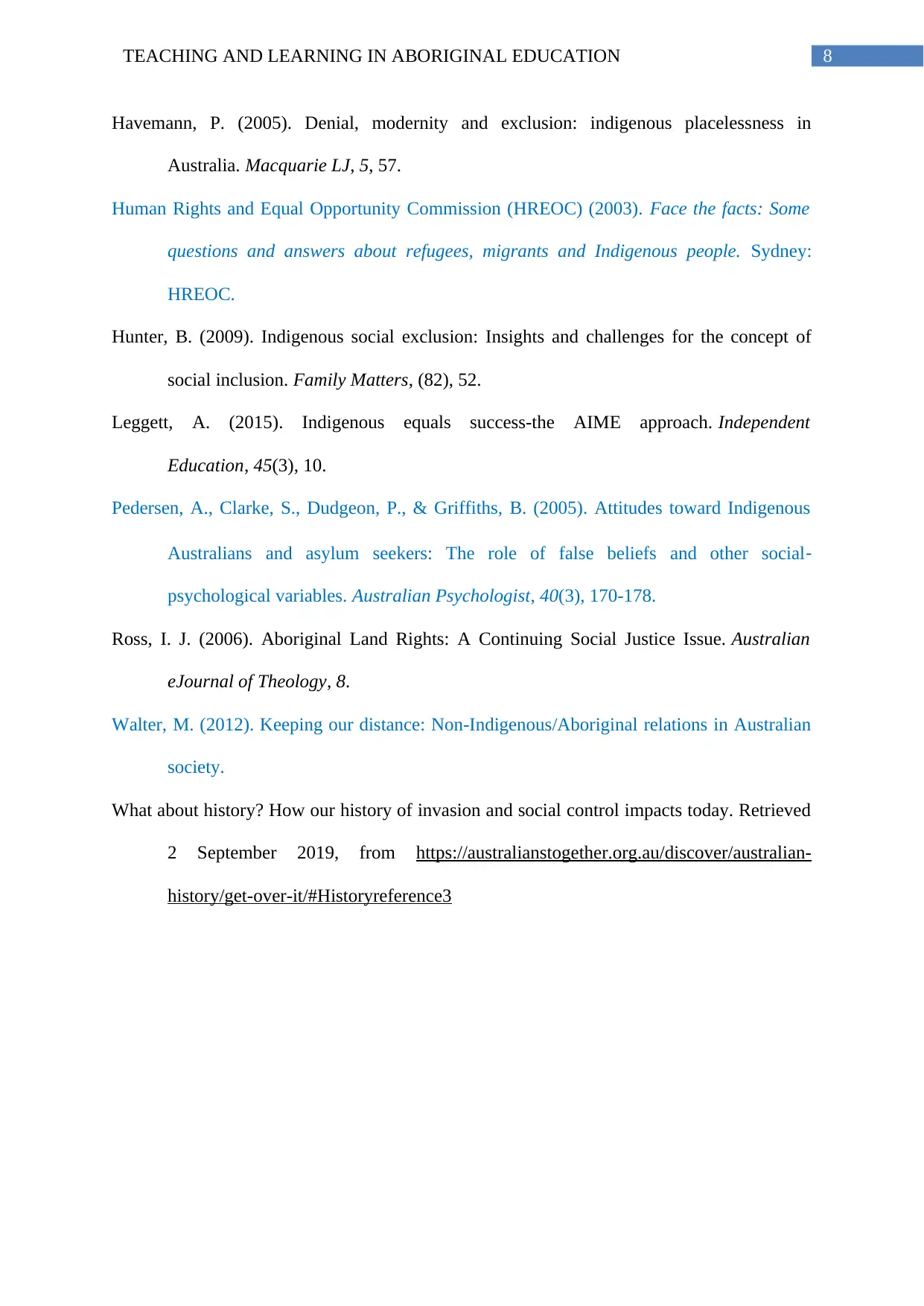
8TEACHING AND LEARNING IN ABORIGINAL EDUCATION
Havemann, P. (2005). Denial, modernity and exclusion: indigenous placelessness in
Australia. Macquarie LJ, 5, 57.
Human Rights and Equal Opportunity Commission (HREOC) (2003). Face the facts: Some
questions and answers about refugees, migrants and Indigenous people. Sydney:
HREOC.
Hunter, B. (2009). Indigenous social exclusion: Insights and challenges for the concept of
social inclusion. Family Matters, (82), 52.
Leggett, A. (2015). Indigenous equals success-the AIME approach. Independent
Education, 45(3), 10.
Pedersen, A., Clarke, S., Dudgeon, P., & Griffiths, B. (2005). Attitudes toward Indigenous
Australians and asylum seekers: The role of false beliefs and other social‐
psychological variables. Australian Psychologist, 40(3), 170-178.
Ross, I. J. (2006). Aboriginal Land Rights: A Continuing Social Justice Issue. Australian
eJournal of Theology, 8.
Walter, M. (2012). Keeping our distance: Non-Indigenous/Aboriginal relations in Australian
society.
What about history? How our history of invasion and social control impacts today. Retrieved
2 September 2019, from https://australianstogether.org.au/discover/australian-
history/get-over-it/#Historyreference3
Havemann, P. (2005). Denial, modernity and exclusion: indigenous placelessness in
Australia. Macquarie LJ, 5, 57.
Human Rights and Equal Opportunity Commission (HREOC) (2003). Face the facts: Some
questions and answers about refugees, migrants and Indigenous people. Sydney:
HREOC.
Hunter, B. (2009). Indigenous social exclusion: Insights and challenges for the concept of
social inclusion. Family Matters, (82), 52.
Leggett, A. (2015). Indigenous equals success-the AIME approach. Independent
Education, 45(3), 10.
Pedersen, A., Clarke, S., Dudgeon, P., & Griffiths, B. (2005). Attitudes toward Indigenous
Australians and asylum seekers: The role of false beliefs and other social‐
psychological variables. Australian Psychologist, 40(3), 170-178.
Ross, I. J. (2006). Aboriginal Land Rights: A Continuing Social Justice Issue. Australian
eJournal of Theology, 8.
Walter, M. (2012). Keeping our distance: Non-Indigenous/Aboriginal relations in Australian
society.
What about history? How our history of invasion and social control impacts today. Retrieved
2 September 2019, from https://australianstogether.org.au/discover/australian-
history/get-over-it/#Historyreference3
1 out of 9
Related Documents
Your All-in-One AI-Powered Toolkit for Academic Success.
+13062052269
info@desklib.com
Available 24*7 on WhatsApp / Email
![[object Object]](/_next/static/media/star-bottom.7253800d.svg)
Unlock your academic potential
© 2024 | Zucol Services PVT LTD | All rights reserved.





